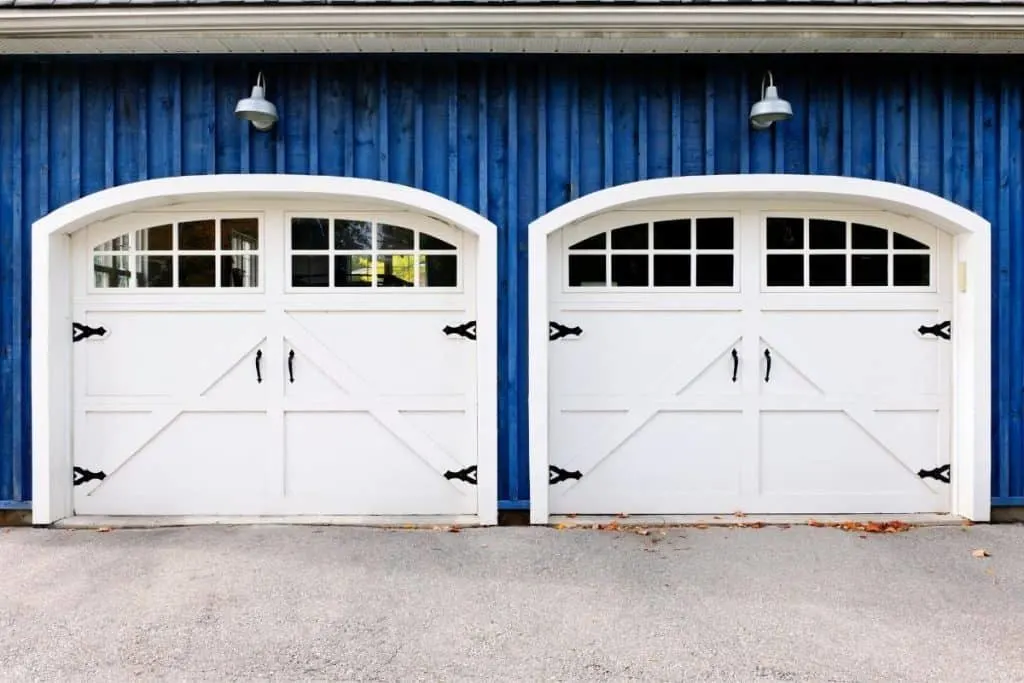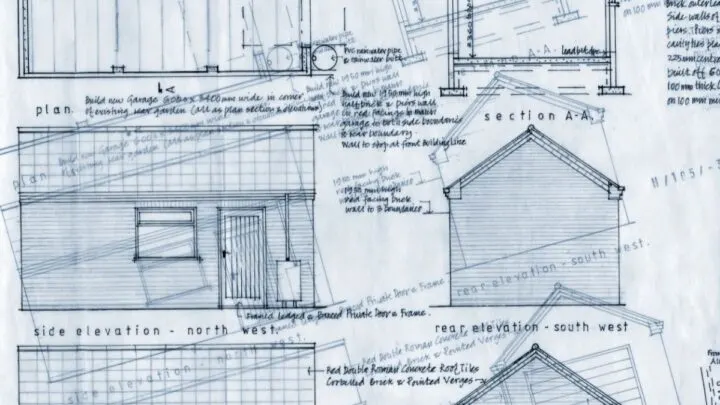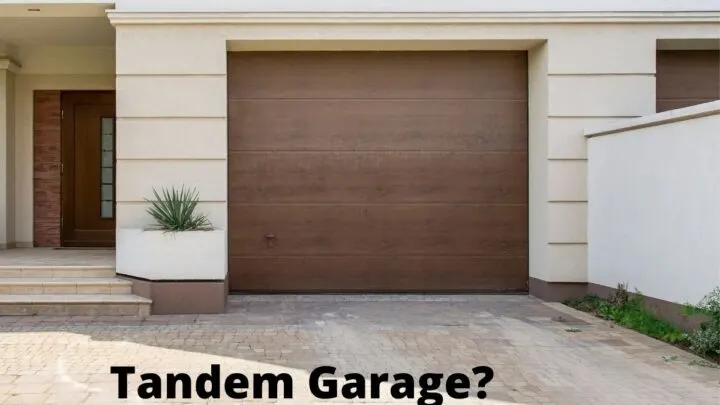I grew up in a standard house. My parents had two cars that they kept in our double garage. I knew there were families wealthier than mine; I could tell by their three, four, even five-car garages.
It wasn’t until I was older that I learned the number of garage doors doesn’t always denote the number of cars. A single garage door can be the gateway to a hundred-foot room, and you would never know from the outside.
But what is this mysterious type of garage, you may ask? It is known as the tandem garage!
Tandem garages align vehicles in a line instead of side by side. Tandem garages are often found in 2-car configurations but can also exist in three, four, and five-car versions as well.
With that in mind, keep reading to learn more about why it’s called a tandem garage and about the different types of tandem garages!
What Does ‘Tandem Garage’ Mean?
So, what is a tandem garage?
To understand the purpose of a tandem garage, let’s first define the word tandem. Tandem traditionally referred to how horses were harnessed to a carriage in a line; today, it just denotes position.
Tandem means to have two or more things arranged in a line. The most common example you may know is the tandem bicycle, where two riders sit one behind another on a two-seater bike.
A tandem garage is the same thing. Instead of having cars side by side like in a double garage, the cars are in line.
The most common tandem garage is a two-car garage with a single door, but there are many arrangements and combinations that are still considered tandem.
The difference between regular double garages and two-car tandem garages is much the same as an everyday kitchen and a galley kitchen.
For many people, the tandem garage style is the better, more space-saving option, just as a galley kitchen is. In a galley kitchen, you won’t find islands or wrap-around counters that take up a lot of space.
Similarly, tandem garages can be fitted better to many house designs!
By creating a longer, thinner garage, the builder can cut down on extra space that a double garage uses and fit a garage to a house that cannot accommodate as much width.

Types of Tandem Garages
There is a nearly endless number of variations for tandem garages. As many ways as you can build a house, you can create a tandem garage.
The most common tandem garage design is a simple two-car garage. There is a driveway leading to a single door, and inside, the garage is one car width wide and two car lengths deep.
A variation for a house with more room is a drive-through tandem garage. This design features a door and driveway on both ends of the garage. It is more common on larger properties and two or more car garages.
While tandem garages can be as many cars long as you want, you will more often see a combination of double and tandem garages. In the case of a three-car garage, this may mean that the front of the garage is two cars wide, and one side extends back another car length.
Additionally, regardless of the configuration, many tandem garages have extra room either at the back or sides. The extra space is usually only half a car’s worth, or so, but can be used as storage, a workshop, or for bikes and motorcycles.
Why are Tandem Garages Used
Knowing all this, you may be thinking that tandem garages are inconvenient. My first thought was undoubtedly something similar. So why do people use them?
There are several reasons someone might opt for a tandem garage. Tandem garages offer a similar amount of space to regular garages but in a more economical fashion.
For starters, tandem garages have smaller driveways, which means less space is used, and there is half as much work to do if you need to clear snow or have it repaved.
Additionally, tandem garages work in places where wider ones would not. If the property is narrow or the neighborhood is crowded, homeowners might opt for a tandem garage rather than no garage at all.
Many homes from the modern era were built with tandem garages, and it is too expensive to alter them.
Many homes with covered or uncovered driveways along the side of the house were later retrofitted with tandem garages simply because they fit.
While your first thought might be that regular double car garages are better, think about how you and your neighbors park now. Many people have too many cars, or their garages are so full of stuff that they can’t use them!
In the end, people end up using their driveway for parking, and if they have additional cars in the garage, they end up parking in tandem anyways.
Pros and Cons of Tandem Garages
While tandem garages can be useful, and, in some cases, are the only option, they do have drawbacks.
The obvious drawback of having a tandem garage is that you have to move your cars to get to the one at the end. If it is a two-car tandem drive-through garage, then this is a non-issue, but if it has more than two cars or is not a drive-through, then there will be times when you have to shuffle cars.
Another problem with tandem garages is that they are simply not as popular. It may be hard to find one if you are looking for a house with a tandem garage. Conversely, if you’ve got one and want to sell your home, few people will want to buy it.
As mentioned above, however, tandem garages are a fabulous way to save space and even get some additional workshop space. They fit better on narrow properties and are easier to retrofit.
In addition, a tandem garage has a unique aesthetic appeal both inside and out. The single door and smaller driveway offer a cleaner look to the house and are easier to maintain.
If you don’t mind the inconvenience of moving cars on occasion or if you have seasonal vehicles, then a tandem garage is just as good if not better than a standard wide one.

Typical Tandem Garage Dimensions
While tandem garages and, indeed, all garages can vary greatly in design and size, the typical tandem garage only needs to be large enough to accommodate two cars end to end.
Let’s start by figuring out how big an average car is. According to reference.com, the average midsize car – think of a four-door family sedan – is approximately six and a half feet by fifteen and a half feet.
A single car garage needs enough space to fit both the car with the doors open and a person’s width around all sides. A typical single-car garage is usually around twelve feet by twenty-two feet.
A standard to small double car garage is usually twenty-four by twenty-two feet.
A tandem garage, on the other hand, typically measures twelve by forty feet.
If you compare these average measures, you can see that a double garage is, quite literally, twice that of a single-car garage. Also, a tandem garage is forty-eight square feet less than a double car garage, though it can still comfortably fit two cars.
The most significant difference between a double car garage and a tandem garage is the space between cars. While in a typical double car garage, there are about six feet between the two vehicles and three on all other sides, a tandem garage only has three feet between the cars and all sides.
How Deep are Tandem Garages?
I don’t know about you, but I like all my rooms to be multi-use, and that extends to my garage.
While a typical tandem garage may only be forty feet long or so, if you have the space, why not expand?
Many tandem garage owners like the layout as it is well-suited to storing equipment, trailers, or using as workshop space. While you may only have two cars, you probably also have bicycles, power tools, a snowblower, sports equipment, and toys.
If you want to be able to accommodate all of those things, you will need more than forty feet!
Tandem Garage vs. Double Garage
So, in the end, is there a definitive winner? Can we say for sure if a tandem garage is better than a double garage?
Well, unfortunately, no. If I had to pick, I would want a double garage simply for the convenience of not having to shuffle cars around.
Perhaps you feel differently. Maybe that itty bitty disadvantage doesn’t bother you. In the end, it’s all a matter of preference!
What I can say for sure, however, is that tandem and double garages serve different purposes and have other benefits.
While a double garage may be more convenient for some, it also takes up more space. Not to mention, it doesn’t make for the most attractive façade. A single garage door tucked alongside a house is much more appealing than two garage doors staring you down at the front of a home.
Tandem garages are usually slightly cheaper to build and have more varied uses than double garages. A double garage also comes with a double driveway. If you don’t mind clearing snow and whatnot, this isn’t much of an issue, but more driveway also means less yard.
While there is no definitive winner of the garage wars, there are differences. Before settling on a design, you need to plan ahead and figure out what you want out of your garage.
How to Best Use a Tandem Garage
As we’ve discussed, tandem garages are great space-savers. A tandem garage is often the best solution for any footprint too small or narrow for a double garage.
But once you’ve got your tandem garage in place, what do you do with it?
Sure, you can use it to store cars; that’s what it’s for! But how do you get the most out of it?
If you want to take full advantage of your tandem garage, think about the layout. Do you have a car you use left often? Do you always go to work before your partner? Do you drive a motorcycle or other seasonal vehicle?
Maybe, you only have one car, but you have a boat or trailer to store. If you have the height, why not install a car lift or loft storage? Just because the space is small doesn’t mean you can’t use it all.
Most tandem garages have a bit of wiggle room. If you get good at parking strategically – as close to the door and the other car as possible – then you’ll find you have plenty of room at the end. You can install a whole workshop or use it instead of a shed.
Not only do tandem garages help condense the house’s overall footprint, but they can free up space outdoors. If you live in a townhouse or multiplex, you probably don’t have a lot of yard space.
A tandem garage can prevent turning your backyard into a garage.
Frequently Asked Questios (FAQs)
What is a 3 car tandem garage?
Three-car tandem garages are most often arranged in an L-shape with a width of two cars and one side two cars deep. There can also be three-car tandem garages that have all three cars in a row, but you are most likely to find these done in the drive-through style.
What is a 2.5 car tandem garage?
While there is no clear definition for what a two-and-a-half-car garage is, it’s basically a two-car garage with extra room. In the case of a tandem garage, this may look like a regular two-car tandem garage with an extra half car length or extra width around the cars.
What is a tandem 4 car garage?
While there is no limit to the layouts for four-car tandem garages, most of them are arranged in a two-by-two pattern. This means the garage is two cars wide and two cars deep. Another common layout is three cars wide with one spot two cars deep, like an L-shape.
What is a tandem 5 car garage?
Five-car tandem garages are extremely uncommon. When a garage gets that big, you are more likely to find a two by three six-car tandem garage. A five-car tandem garage would very likely be three cars wide and two cars deep in two spaces.


